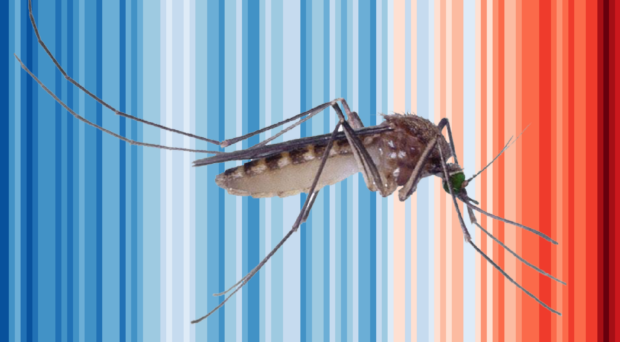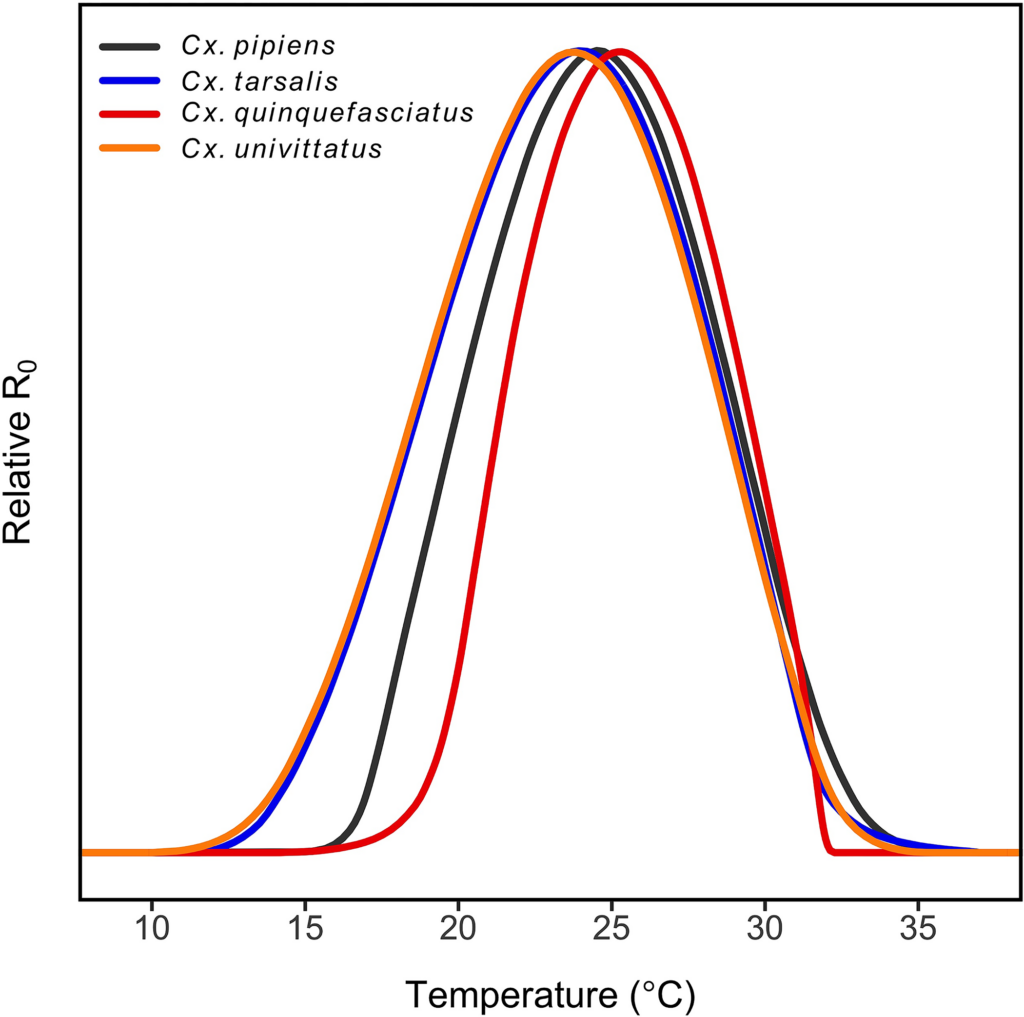
Climate change is all around us, from heatwaves and wildfires in Canada, to a typhoon in the Western Pacific. In addition to increasing the frequency and magnitude of extreme weather events, climate change is also documented to increase the range and frequency of vector-borne diseases. For example, malaria transmission seasons might increase in areas of previously low transmission due to climate change, such as in the eastern Mediterranean, highland areas of Africa or South America, putting billions more people at risk of infection.
The most widespread arboviral pathogen globally is West Nile virus, including in Washington State in the United States, where I live. When I heard about the El Niño – Southern Oscillation turning from La Niña into it’s El Niño warm phase, my first instinct was to jump to the conclusion that the warm, dry summers associated with El Niño in our area will lead to an increase in West Nile virus transmission risk. However, a quick literature search did not result in finding sources to support such conclusions. In fact, I started to wonder about the projected impact of climate change on West Nile virus risk, given that climate change leads to hotter and drier conditions as well, similarly to El Niño. This is why I was happy to get a notification email for a new review paper, published in the journal PLOS Climate by Julian Heidecke, Andrea Lavarello Schettini, and Joacim Rocklöv, all at the Interdisciplinary Center for Scientific Computing and Heidelberg Institute of Global Health at Heidelberg University in Germany, about the impact of climate change on West Nile virus transmission.
This paper does a good job of summarizing the ecology of West Nile virus, both in Europe and in the United States, where different vector and host species fill in their roles in the ecology of this arbovirus. It s a treasure-trove of relevant citations for those wanting to follow up on the details, including a paper that I coauthored. However, in addition to this, they also summarize what is known and what is yet to be discoved about the impact of climate change on West Nile virus transmission risk. In general, the authors describe a consensus that climate change increases West Nile virus transmission risk to people, through several different pathways. These pathways include impacts on the abundance, distribution and behavior of both mosquito vectors and avian hosts; the contact rate between vectors and hosts; and the replication of the virus in vectors.
Climate change impacts both the abundance, distribution and behavior of Culex mosquito vectors. Increased temperatures due to climate change allow these mosquitoes to lengthen their activity season, increase their abundance in some regions, and expand their geographic distribution, both to higher latitudes and altitudes, introducing them to new ecosystems with naïve host populations. At the same time, some areas might become too hot for some Culex mosquito species, reducing their abundance, especially during hot periods of the year. Different Culex mosquito species might occupy areas that match their climatic tolerance better, complementing each other in transmitting West Nile virus. At the same time, warmer temperatures allow the virus to replicate faster in mosquito vectors, shortening the extrinsic incubation period, and potentially increasing vector competence, i.e. the probability that an infected mosquito would transmit the virus to a competent host. Precipitation extremes such as increased rainfall and drought have complex impacts on mosquito vectors. While increased precipitation can create additional breeding sites for mosquitoes, heavy rainfall can flush mosquito larvae away. Similarly, while drought might deny mosquitoes their breeding sites, it can also concentrate nutrients and hosts around remaining water bodies, creating efficient foci of infection for viral amplification.
The migration pattern of avian hosts of West Nile virus could be impacted by climate change. Climate change-induced changes have already been observed in the migration patterns of several avian host species, including the timing, migration routes, abundance, and composition of avian assemblages. Long-distance migratory birds tend to arrive to temperate regions earlier in the spring. In addition, warming temperatures are also impacting the physiology of birds, demonstrated through changes in their egg-laying date, body condition and number of offspring. These changes in the abundance, distribution and physiology of avian hosts will cascade to impact the emergence and distribution of West Nile virus. This could happen through impacting the biting behavior of mosquito vectors; the competence, susceptibility and role of specific bird species in amplifying West Nile virus; as well as shifts in the feeding behavior of Culex mosquitoes between different hosts including people.

Integrating these multiple different pathways through which climate change can impact West Nile virus transmission is challenging. The authors review both data-driven and process-based models as alternative methods for integrating and predicting WNV risk, and how these approaches incorporate climatic variables, through specific studies. In particular, they highlight a specific study by Shocket et al. (2020), that uses trait-based models to characterize the transmission-dependent transmission of ten different mosquito-virus pairs, via calculating the basic reproductive number. This study found that transmission risk peaked around 24 Celsius, but was possible between 12 and 35 Celsius degrees. The authors of that paper specifically demonstrated that the mean incidence of West Nile virus disease across US counties also peaked at 24 Celsius. Interestingly, between 2001-2016, 70% of the counties were below this optimum temperature for transmission, and therefore the area with optimal temperature is expected to increase with climate change, putting more people at risk. Similarly, several studies found that a considerable part of WNV risk in Europe could be explained by mean summer temperature in the preceding year, a mild winter, low winter precipitation, and total annual precipitation in the preceding year. In particular, the largest increases in West Nile virus risk was predicted in northern and western Europe, but with absolute risk remaining highest in southern, central and eastern Europe. Based on different climate change scenarios, this would mean an additional 161-244 million people at risk of WNV transmission by 2050, with most in western Europe. While the current climate in the UK is not suitable for WNV introduction, a different study found that the risk of transient outbreaks might substantially increase after 2050. For the United States, a different study projected a doubling of annual WNV cases by 2050 through intensified drought under the “business as usual” climate scenario.
Despite reviewing a considerable literature on the impact of climate change on WNV transmission, the authors highlight the exceptional difficulty of predicting WNV transmission. Most studies, analyses, models and predictions only apply to limited spatial scales. Some of this is due to actual spatial variation in the ecology of West Nile virus, such as different host and vector species in different regions of the United States, as well as between the US and Europe. However, they also highlight a knowledge gap in the transmission cycle of WNV, especially the interplay between vector and host distributions, abundance, competence, and vector feeding preferences which has only been studied for a few species and at a few study sites. Many times, datasets are collected between disparate entities, such as health departments, mosquito control district, academic researchers, who might not share their data, coordinate studies, or even be aware of each other’s activities. Finally, the authors advocate for the integration of other data sources, such as habitat change, socio-economic development, human behavior, travel and trade, in order to fully evaluate the potential impact of human activities on WNV transmission risk as well as the number of people potentially exposed to the virus. The One Health concept, which we have recently discussed, is the perfect vehicle to integrate so wide-ranging societal and ecological data, in order to fully conceptualize the impact of climate change on West Nile virus risk. However, at the end of the day, the most important decision we can make is to commit to stop emitting CO2 and other greenhouse gases as soon as possible. Until we do that, we’re looking at an ever-increasing risk of West Nile virus transmission, and many even more severe consequences.

Comments